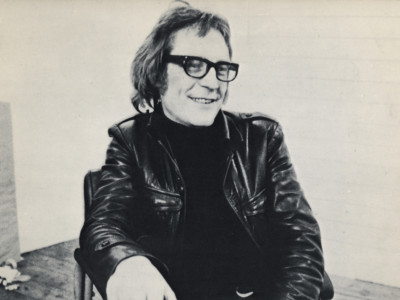
James Christie: the eloquent auctioneer
By Martin Oldham
Published on 8 September 2016
As Christie’s auction house celebrates 250 years of wielding the gavel, Martin Oldham tracks down its founder James Christie, a man who turned the humble auction into the spectacle it remains to this day.
From the Autumn 2016 issue of RA Magazine, issued quarterly to Friends of the RA.
On Friday 5 December 1766, an auction took place in London of what was advertised as "the genuine household furniture, jewels, plate, fire-arms etc... the property of a noble personage (deceas’d)". An unremarkable sale for its time, it included all manner of household items such as a pair of sheets, two pillowcases and two chamber pots. But posterity has bestowed upon it a special significance, because this was the first auction from his permanent sale room in Pall Mall of James Christie (1730–1803). Modest beginnings, but from there grew the Christie’s brand, a multi- billion pound global art business that this year celebrates its 250th anniversary.
Christie was quick to realise he was never going to make it big by selling bed sheets and chamber pots. He held his first sale of paintings in March 1767: "a genuine and valuable collection of Italian, French and Flemish pictures, consigned from abroad". It was not a great success – the paintings might not have been as genuine as advertised, nor particularly valuable: most failed to find a buyer, the sale raising a meagre £244 18s in total. However, subsequent picture sales proved to be more lucrative, and a succession of important consignments in the 1770s cemented his reputation. In 1778 he arranged the private-treaty sale of Robert Walpole’s paintings – the Houghton Hall collection – to Catherine the Great of Russia for £40,000. The five-day sale of the contents of Joshua Reynolds PRA’s studio in 1795 realised £10,319. By his death in 1803, Christie had become the leading auctioneer in London, his name synonymous with selling fine art.

His success was partly down to courting a network of influential dealers and agents, and a roster of rich clientele, which gave him the advantage in attracting the best consignments. He mixed easily in the cosmopolitan and artistic circles of the capital, counting among his friends the actor David Garrick, the writer and connoisseur Horace Walpole, and the Academicians Reynolds and Gainsborough. Gainsborough’s 1778 portrait (pictured) depicts Christie as an urbane and good-humoured man, going about his business with relaxed confidence, catalogue in hand, elbow resting on a stack of paintings.
Prior to Christie, auctions had been mundane affairs. He turned them into entertainment, aimed as much at the burgeoning middle classes as at wealthy collectors and connoisseurs. His ‘private view days’ became celebrated social events, and his showroom one of the few venues in London where people could see Old Master paintings prior to the advent of public museums. Known for his persuasive manner and verbal flourishes, Christie brought an element of showmanship to proceedings. In one satirical cartoon he was dubbed ‘Eloquence, or The King of Epithets’; in another – ‘The Specious Orator’ – he is shown in characteristic pose, leaning forward from his rostrum, gavel in hand, cajoling a bidder to part with "£50,000 – a mere trifle".
If he were to return today, what would James Christie make of the auction house he founded? Much has changed in the art business, not least the more scrupulous attention paid to questions of authenticity, attribution and provenance. But the one place he would still feel at home would be inside the ‘Great Room’, where the protocols and performance of auctioneering still follow those he was so influential in establishing. And it might amuse him to discover that Christie’s recently sold an 18th-century English Delft polychrome chamber pot for £2,500.

Bowie’s art collection leads autumn auctions
Newspaper reports about prices in the millions obscure the best thing about art auctions: the free public exhibitions beforehand. Sotheby’s has a crowd-puller on the cards with its ten-day show of David Bowie’s art collection (sales 10 & 11 Nov; preview 1–10 Nov). Bowie’s open musical mind was reflected in his taste for art, which ranged from African art to avant-garde design, modern British to Jean- Michel Basquiat (Air Power, 1984, pictured). The collection of Royal Academicians Mary Fedden and Julian Trevelyan is also for sale at Sotheby’s (sale 23 Sep; preview 18–22 Sep). The artist couple’s post-war paintings are complemented by works received as gifts from friends, including Picasso and Henry Moore. The proceeds support the restoration of their studios at London’s Durham Wharf into a workplace for future generations of artists.
The late art critic Brian Sewell was hard to please, so it will be fascinating to see what made the grade when it came to his own acquisitions, when his collection goes on sale at Christie’s (sale 27 Sep; preview 24–26 Sep). And ahead of the British Museum’s major show of South African art, Bonhams in London continues its series of auctions on this underexposed area of international art (sale 14 Sep; preview 11–14 Sep). Sam Phillips

Enjoyed this article?
As well as free entry to all of our exhibitions, Friends of the RA enjoy one of Britain’s most respected art magazines, delivered directly to your door. Why not join the club?
Related articles

Visions from Ukraine
19 June 2024

10 RA Schools stories through the centuries
16 May 2024

In memoriam: Mick Moon RA
1 May 2024